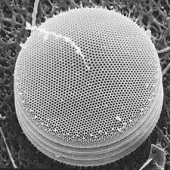Light absorption enhancement with bio-inspired nanostructures

Sunlight is the primary energy source for life on earth. In some habitats like the ocean the solar irradiance is reduced. Species living in such an environment have developed strategies to harvest the scarce sunlight in an effective way: Diatoms, a unicellular microalga, have a silica microshell with intriguing optical properties [1]. The planktonic living algae utilize this feature to collect the sparse sunlight and maximize their rate of photosynthesis [2]. A similar problem needs to be overcome by the solar panels that power spacecraft. The size of the solar arrays is proportional to the power demand of the spacecraft. Making the absorption of sunlight in the solar arrays more effective provide more power to the spacecraft and alleviate mission analysis constraints.
The silica microshell of diatoms is species-specific and can have various shapes. All diatoms have a silica shell that contains pores that can have either a circular, elongated or polygonal [3]. For example the shell of the diatom Coscinodiscus sp. is built up by several porous layers with different pore sizes and lattice constants in a hexagonal array [1,4]. The pore size increases from ca. 50 nm in the outermost layer to 1300 nm in the innermost layer with lattice constants from 200 nm to 2000 nm [1]. This structure is a natural three-dimensional photonic crystal. The optical properties of the silica shell have been described to be capable of “light-trapping” [1], “lensless light focusing” [5] or “light-confining” [2]. The physical manipulation of the light is based on the superposition of scattered light. Consequently the photonic crystal layers act differently on varying wavelengths and polarizations [6]. In previous research, two-dimensional photonic crystals with patterns comparable to the diatom shell have been successfully applied to single junction solar cells [7] and thin-film solar cells [1].
Another natural structure with potential to enhance solar cells in space are bio-inspired anti-reflective coatings. The model for these structures can be found on the surface of the eyes of several insects, for example moths [8].
This ACT project aims to investigate the potential of enhancing the external quantum efficiency of solar panels used on space craft with bio-inspired nanostructures.
References
- Chen, X., Wang, C., Baker, E., Sun, C. (2017) Numerical and experimental investigation of light trapping effect of nanostructured diatom frustules. Scientific Reports, 5:11977
- De Tommasi, E. (2016): Light Manipulation by single cells: The case of diatoms. Journal of Spectroscopy, 2490128
- Round, F. E., Crawford, R. M., Mann, D. G. (1990) The diatoms. Biology & morphology of the genera. Cambridge University Press, Cambridge, 5
- Fuhrmann, T., Landwehr, S., El Rharbi-Kucki, M., Sumper (2004) Diatoms living as photonic crystals. Applied Physics B 78, 257-260
- De Stefano, L., Rea, I., Rendina, I., De Stefano, M., Moretti, L. (2007) Lensless Light focusing with the centric marine diatom Coscinodiscus walesii. Optics Express 18082, Vol. 15, No. 26
- Joannopoulos J. D., Johnson, S. G., Winn, J. N., Meade, R., D. (2008) Photonic Crystals – Molding the flow of Light. Second Edition, Princeton University Press, 2
- for space applications using two-dimensional photonic crystals. E3S Web of Conferences 16, 16007
- Zhou, H., Xu, J., Liu, X., Zhang, H., Wang, D., Chen, Z., Zhang, D., Fan, T. (2017) Bio-inspired Photonic Materials: Prototypes and Structural Effect Designs for Applications in Solar Energy Manipulation. Advanced Functional Material, 1705309